Machine Learning Statistics 2024
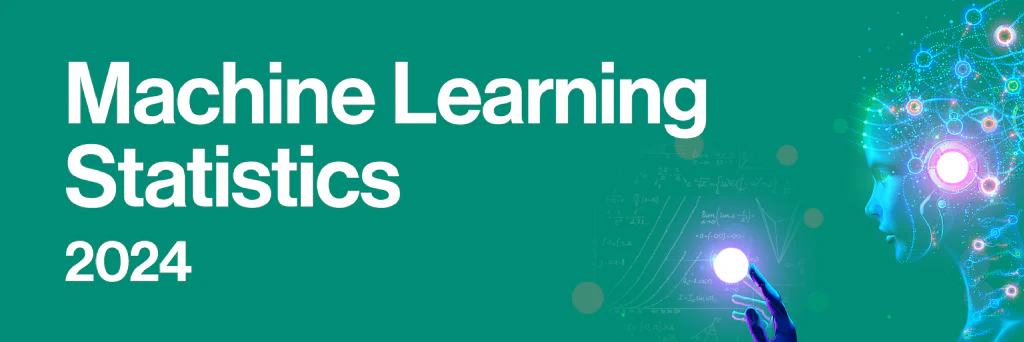
With the growth of AI continuing to accelerate, the interest in machine learning technology has never been greater. As the backdrop to renowned generative AI platforms like ChatGPT, machine learning has transformed the way humans interact with technology.
As such, the growth and development of machine learning will play a pivotal role in how we perform many tasks in the future. That’s why AIPRM has created this report covering the most relevant machine learning statistics for 2024, including market data, usage statistics, and more.
10 Interesting facts about machine learning #
- The global machine learning industry is projected to be worth $79 billion by the end of 2024 – a year-on-year rise of 38%.
- Its global industry value is expected to exceed $500 billion by 2030 – over six times more than in 2024 (+557%).
- The US has the biggest machine learning market of any country, with an expected value of $21.24 billion by the end of 2024 – 40% more than China ($15.15 billion).
- Asia has the biggest machine learning market of any global region at just over $29 billion – 20% more than North America.
- The manufacturing industry is responsible for nearly a fifth (18.88%) of the global machine learning market – the most of any sector.
- Four-fifths (80%) of businesses claim machine learning has helped increase their revenue.
- Over half (57%) of businesses have used machine learning to improve customer experience.
- Nearly half (46%) of businesses claim they’d used machine learning to help detect fraud.
- Around one in five (22%) companies have used machine learning to reduce customer churn.
- Nearly three-quarters (73%) of consumers prefer chatbots to humans when seeking answers to straightforward questions.
Machine learning market statistics #
Recent machine learning statistics predict that the global machine learning industry could be worth more than $79 billion by the end of 2024. This represents a rise of almost two-fifths (38%) from 2023 but remains 42% short of the industry value for 2021.
A breakdown of the global machine learning market size between 2020 and 2023 and the projected size from 2024-2030 #
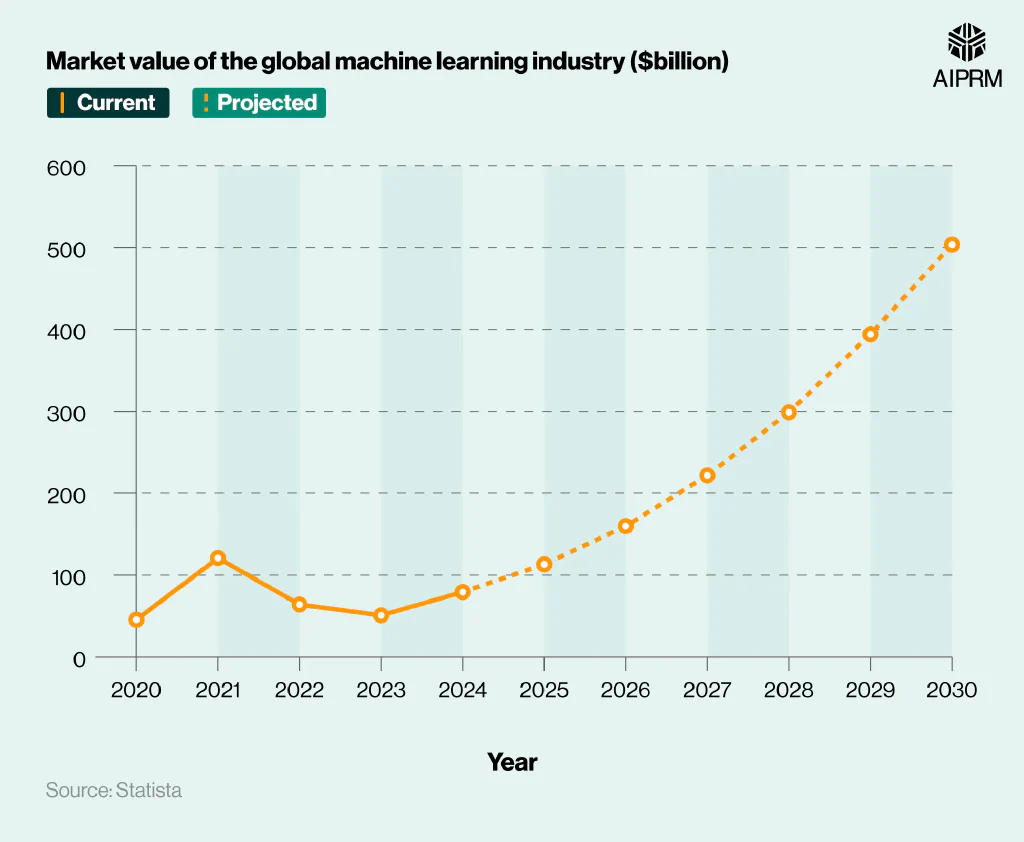
(Figures from 2024 onwards are projections.)
After more than doubling in value (+165%) between 2020 and 2021, the machine learning market fell by nearly half in 2022 (-47%), dropping by a further fifth (21%) in 2023.
The growth of 2024 is expected to continue in the following years, rising by more than two-fifths (+43%) in 2025, before reaching a new peak of $159.8 billion a year later (+41%). Industry revenue is expected to surpass $200 billion for the first time in 2027 (+38%), before reaching $394 billion in 2029 – a two-year rise of 77%.
By 2030, the industry is projected to be worth more than $500 billion – over six times more than in 2024 (+551%) and eleven times more than in 2020 (+1,005%).
How much is the US machine learning industry worth? #
The US machine learning industry is projected to be worth more than $21 billion by the end of 2024 – a rise of more than half from 2023 (+57%). Despite this, the industry remains over a third (34%) lower than its peak value of $32.19 billion in 2021.
A breakdown of the US machine learning market size between 2020 and 2023 and the projected size from 2024-2030 #
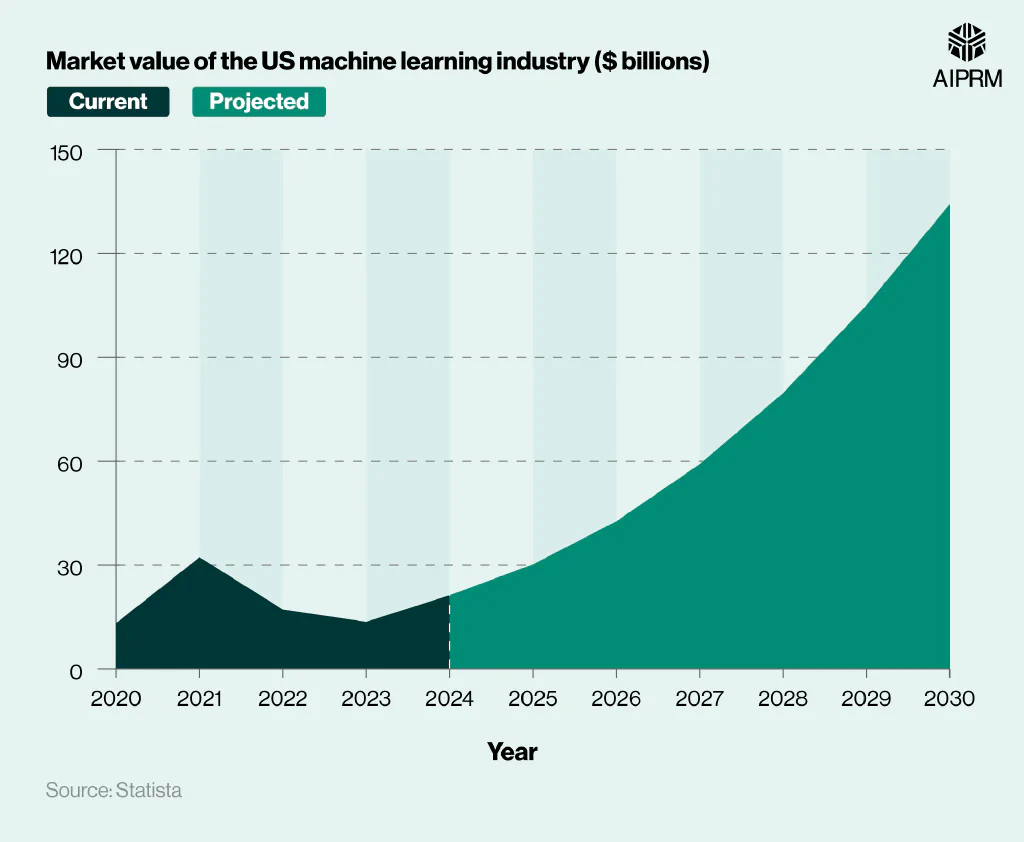
(Figures from 2024 onwards are projections.)
The latest machine learning statistics predict a continued rise in market value between 2025 and 2030. The industry is projected to climb by more than two-fifths (+42%) in 2025, before surpassing $40 billion for the first time in 2026 (+41%).
A continued rise is expected to see its market value go beyond $100 billion in 2029 – more than double the total for 2026 (+146%). If the projected 2030 figure of $134.2 billion is correct, then the US machine learning industry will be over six times (534%) more valuable in 2030 than in 2024.
Feeling confused about AI and machine learning? Our kid’s guide to artificial intelligence and machine learning simplifies the jargon so you can see how this technology can benefit you.
Which country has the biggest machine learning market? #
Analysis of machine learning stats shows that the US leads the way in terms of market value. By the end of 2024, the US machine learning market is projected to be worth $21.24 billion – two-fifths (40%) more than any other country and the only one exceeding $20 billion.
A breakdown of the countries with the highest projected machine learning market value in 2024 #
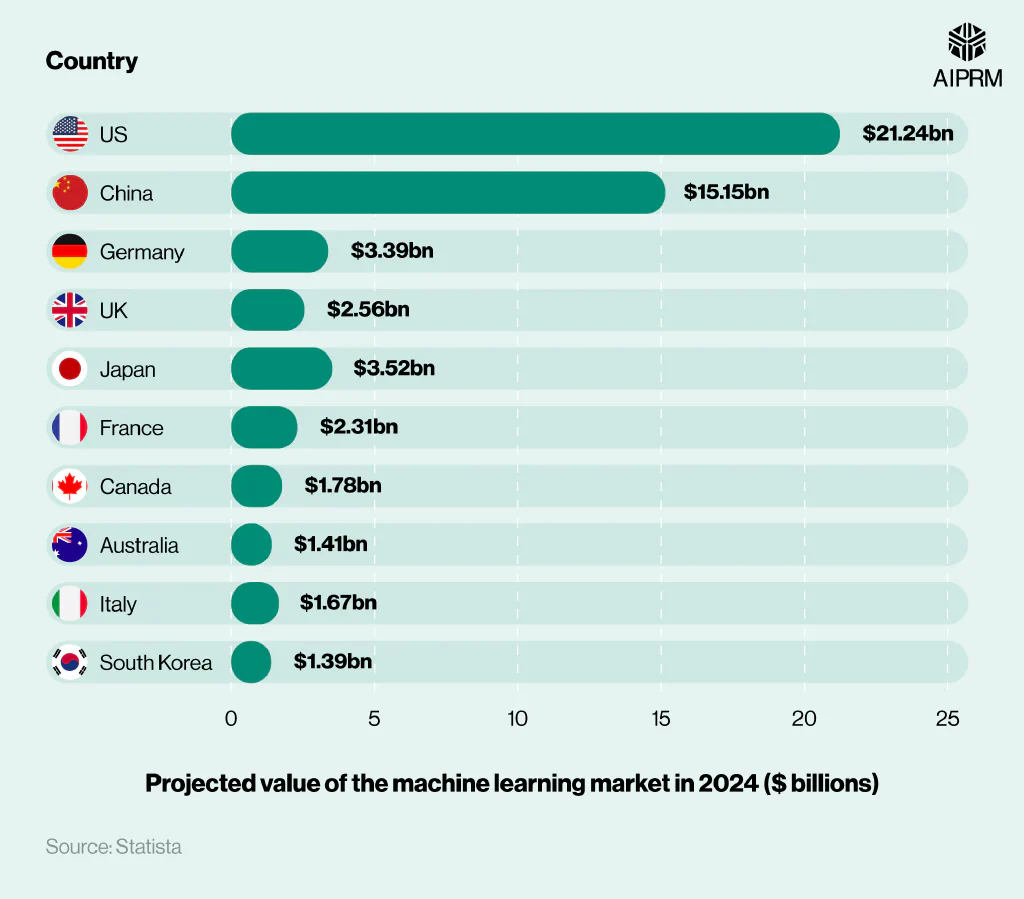
The US is followed by China with a projected market value of above $15 billion. This is more than four times (+347%) that of the next highest nation (Japan), making China the only other nation with a machine learning market value above $10 billion.
There are four other countries with projected market values above $2 billion:
- Japan - $3.52 billion
- Germany - $3.39 billion
- UK - $2.56 billion
- France - $2.31 billion
The combined market value of the US and China’s machine learning industries is more than double the combined value of the rest of the top 10.
Which region has the biggest machine learning market? #
Asia is the global region with the biggest share of the machine learning market. Machine learning statistics show that the continent has a projected industry market value of over $29 billion by the end of 2024 – a fifth (20%) more than any other region.
A breakdown of the countries with the highest projected machine learning market value in 2024 #
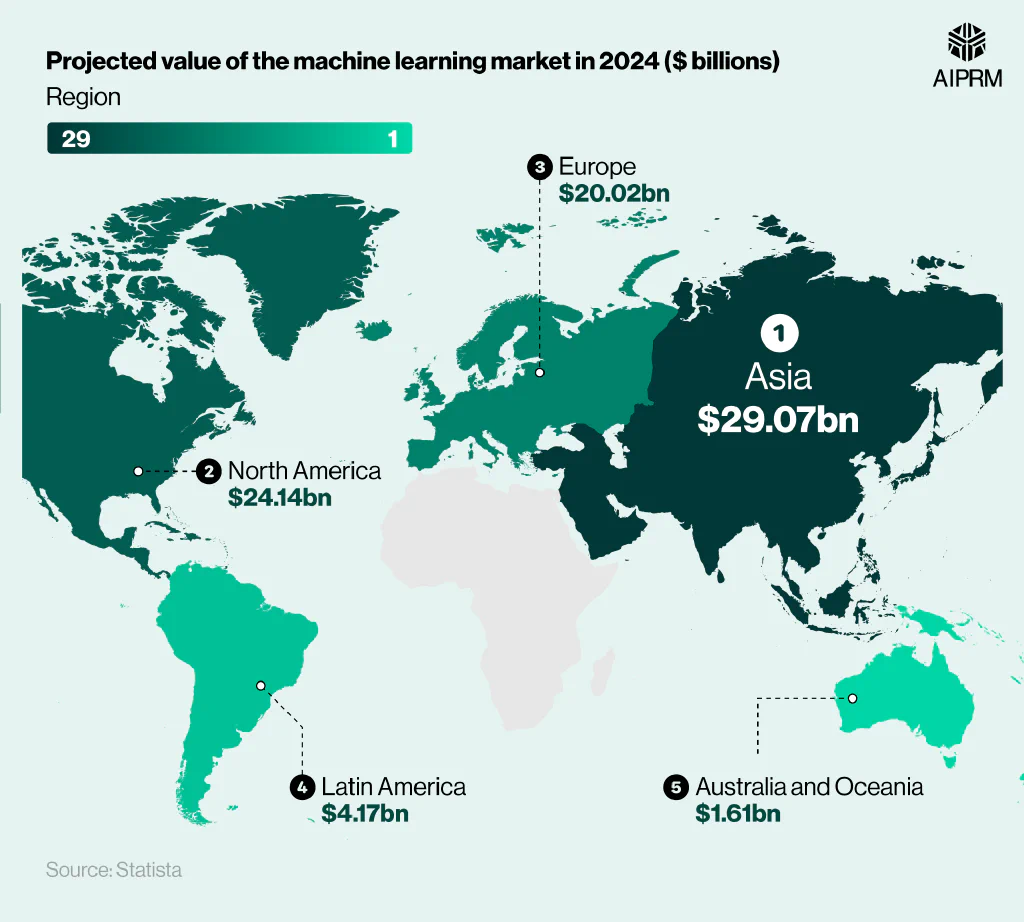
North America has the next highest market value at just under $25 billion. While this was around 17% less than Asia, North America’s market value was over a fifth (21%) more than Europe – the next highest region.
The top three regions were the only ones with projected market values above $10 billion, with Latin America’s total of $4.17 billion equating to just over a fifth (21%) of Europe’s market share.
Australia and Oceania had the lowest value at just over $1.6 billion – 94% less than Asia.
Which industry holds the highest share of the machine learning market? #
Manufacturing companies lead the way for machine learning, accounting for nearly a fifth (18.88%) of the industry’s overall market share. This was over 3% more than any other sector, making manufacturing one of two sectors with market shares above 15%.
A breakdown of the industries with the highest proportion of the global machine learning market in 2022 #
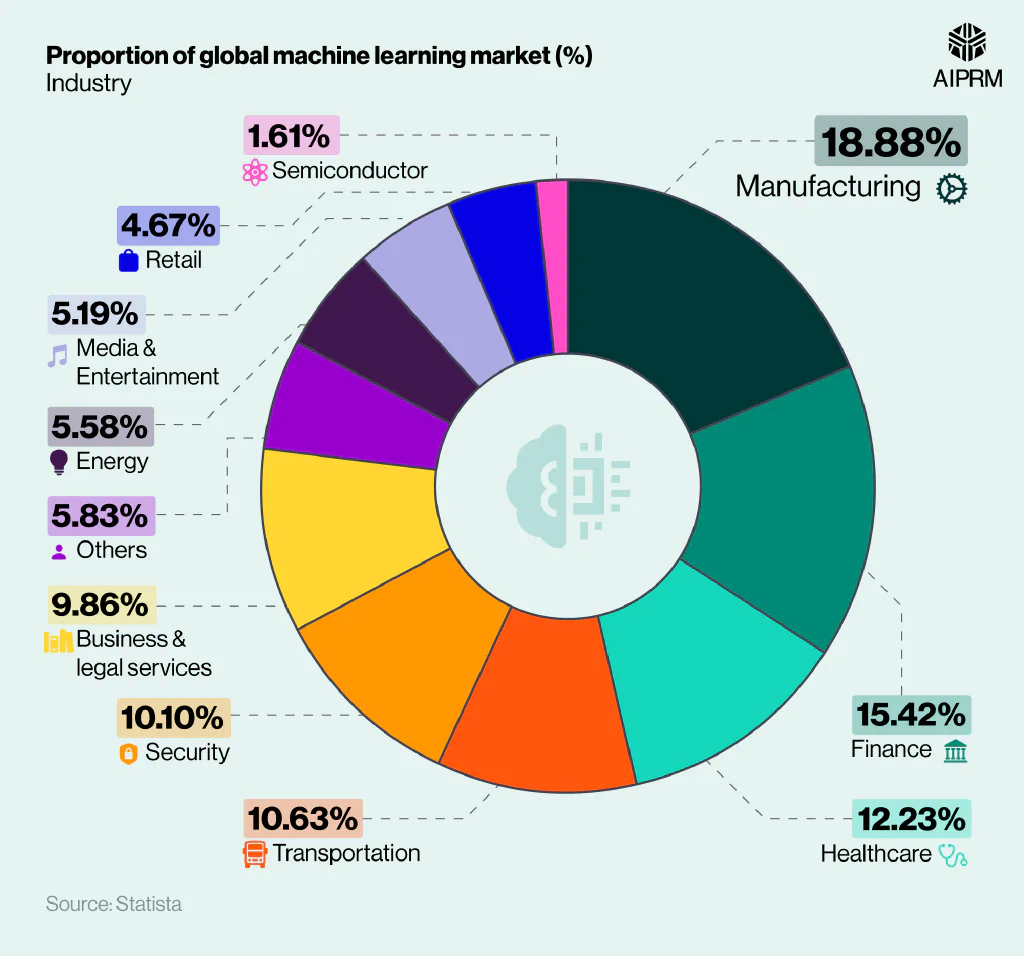
Finance is the sector with the second-highest market share, accounting for just over 15% (15.42%) of the overall industry – around 3% more than third-placed healthcare (12.23%).
Transportation (10.63%) and Security (10.1%) are the only other sectors holding more than a tenth of the industry. This means that, combined, the top five sectors account for more than two-thirds of the overall machine learning market.
Machine learning usage statistics #
A report from Demand Sage found that nearly three-quarters of surveyed companies believe that machine learning will improve their productivity. The same report revealed nearly a fifth (15%) of organizations are advanced machine learning users, with four-fifths (80%) claiming the technology helped increase business revenue.
What are the most common reasons businesses use machine learning? #
Recent machine learning statistics found that more than half (57%) of surveyed businesses use machine learning to improve customer experience. This was 7% more than any other response, with generating consumer insight and intelligence (50%) being the only other cited by at least half of respondents.
A breakdown of the percentage of companies using machine learning for various purposes #
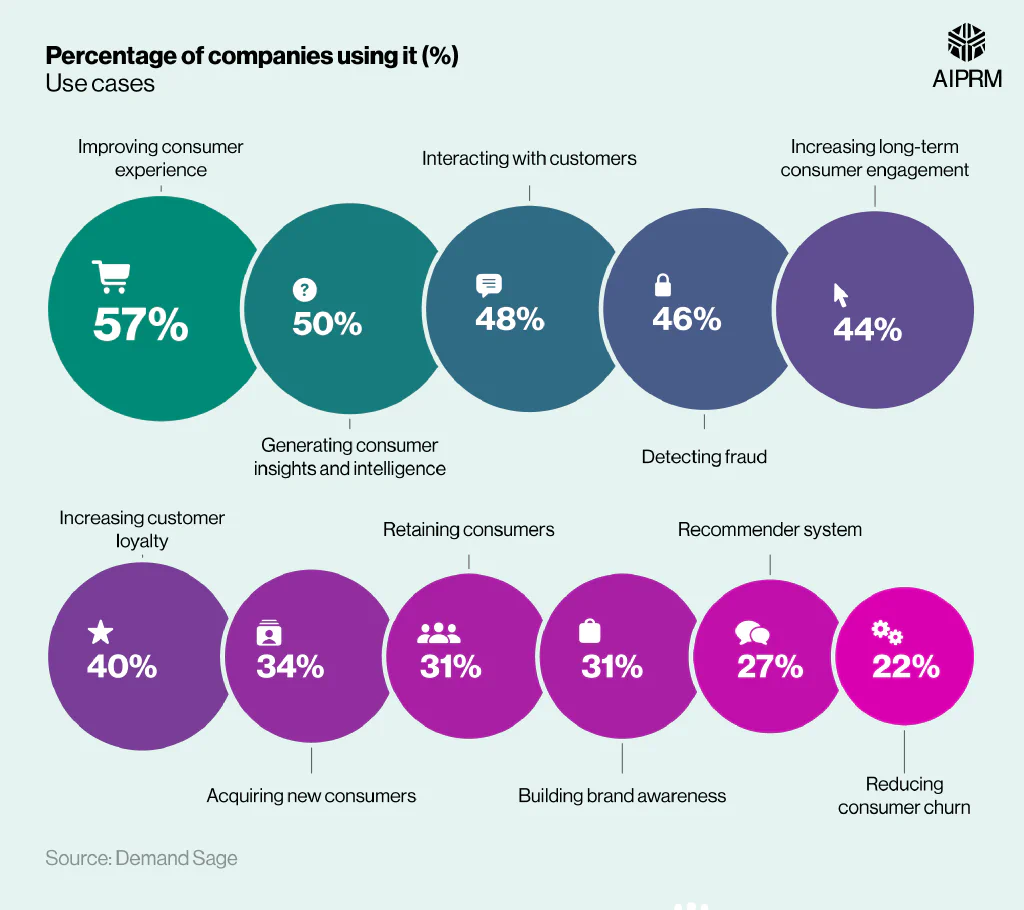
Nearly half of businesses used machine learning for customer interaction (48%) – 2% more than those who used the software to detect fraud (46%).
Increasing long-term customer engagement and increasing customer loyalty were the only other answers given by at least 40% of businesses, with totals of 44% and 40%, respectively.
At the other end of the scale, less than a quarter (22%) of businesses used machine learning to reduce customer churn, with just over a quarter (27%) using the software as a recommender system.
Machine learning adoption statistics #
A survey conducted by Refenitiv found over two-fifths (42%) of US companies said they’d actively deployed AI in their business, with a further 40% claiming they’re actively exploring using the technology in the future.
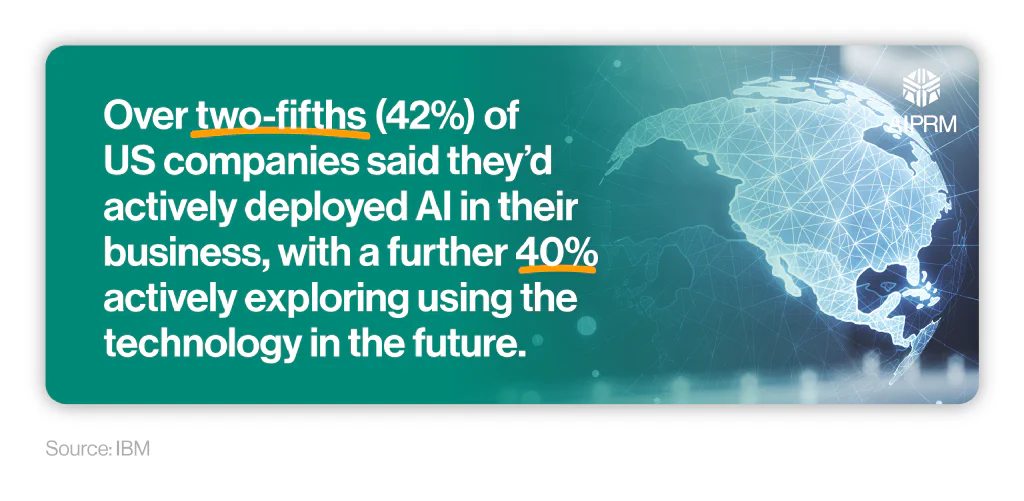
Additionally, a further report from IBM found nearly two-fifths (38%) of IT professionals claim their company is actively implementing generative AI, with another 42% exploring the possibility.
When broken down by industry, financial services lead the way, with half (50%) of the IT professionals in that sector reporting their company had utilized AI.
What are companies’ primary goals when using AI? #
A third (33%) of surveyed businesses claim that the automation of IT processes is driving their AI adoption – the most commonly cited reason. With machine learning being pivotal to the way many AI tools automate IT processes, this suggests that the technology is playing a key role in businesses’ decisions to adopt AI.
A breakdown of the main use cases driving AI adoption among surveyed companies #
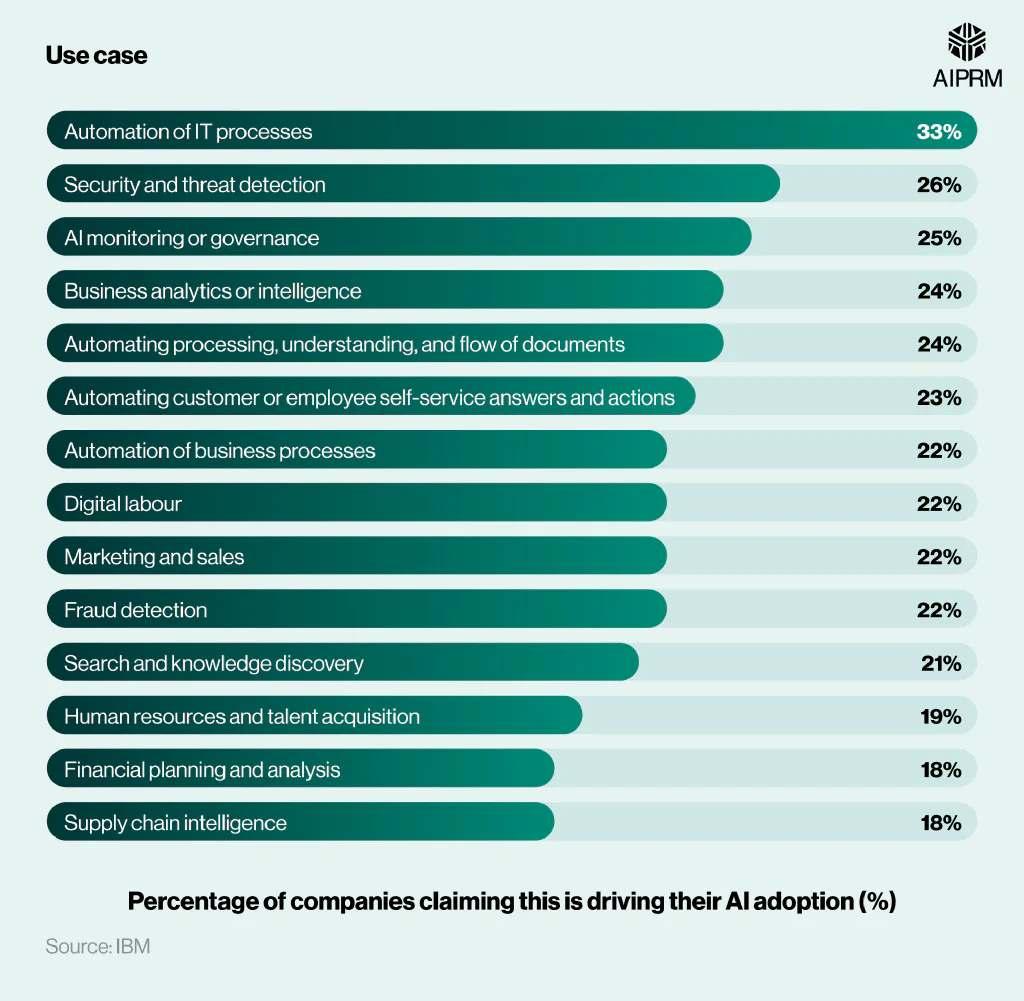
Identifying and detecting security threats were the next common reason, cited by just over a quarter (26%) of businesses – 7% less than the automation of IT processes. Machine learning technology plays a key role in training AI tools to identify patterns found in many security threats, again suggesting a strong link between machine learning and AI adoption.
AI monitoring or governance was cited by 25% of businesses, making it the third-most common answer and the only other one given by at least a quarter of respondents.
Investments in machine learning #
Research from PwC estimated that global GDP could be up to 14% higher in 2030 as a result of AI. This would equate to an additional $15.7 trillion, making it the biggest commercial opportunity in our global economy today. With machine learning at the forefront of AI’s development more than ever since the advent of ChatGPT, it’s likely that the technology will continue to play a pivotal role in the industry’s growth.

Regionally, the greatest gains from AI are projected to be in China, which is expected to see its economy boost by more than a quarter (26%). China is followed by North America, which is predicted to see a boost of up to 14%. The biggest sector gains are expected to occur in retail, financial services, and healthcare.
What are the biggest machine learning platforms? #
OpenAI stands alone as the largest machine learning-based platform. Machine learning statistics show that the company behind ChatGPT has received more than $11 billion in investment, as of 2024. This is nearly 20 times more than the next highest company (ScaleAI), making OpenAI the only one to date that has received more than $1 billion in investment.
A breakdown of the machine learning platforms that have received the most global investment, as of 2024 #
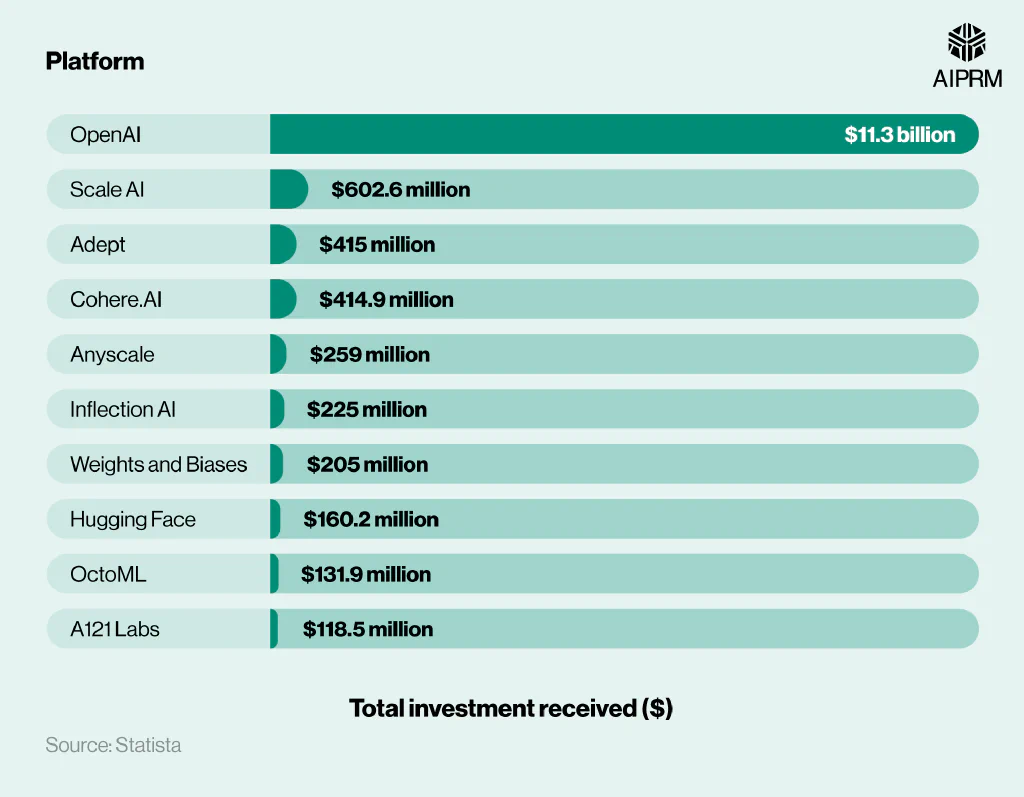
ScaleAI received the second-highest investment, at just over $600 million. This was 45% more than any other company, making the Californian business the only other company to receive more than half a million dollars of global investment.
Adept and Cohere AI were the final two companies to receive at least 400 million dollars in investment, with totals of $415 million and $414.9 million, respectively – around a thirtieth (3.7%) of OpenAI’s total investment.
The future of machine learning #
The evolution of machine learning accelerated in the early 2020s, resulting in the emergence of groundbreaking AI tools like ChatGPT and advancements in the automation of processes in numerous sectors.
The development shows no sign of waning, with the technology expected to advance rapidly in the coming years. Some of the areas in which machine learning is expected to improve are:
Computer vision #
Computer vision is a type of AI that enables computers to independently identify objects in images and videos. The advancements in machine learning technology have seen the average error rate in these tools drop from 26% to 3% in the space of a decade.
Improvements in this sector will allow us to perform image-identifying tasks at a faster rate than ever before. With computer vision tools able to identify thousands of photos in a few minutes, this could eliminate a task that might have taken a human days or even weeks to complete.
Further improvements in computer vision could transform the processes involved in key areas like medical X-rays, airport security, and product manufacturing, to name but a few.
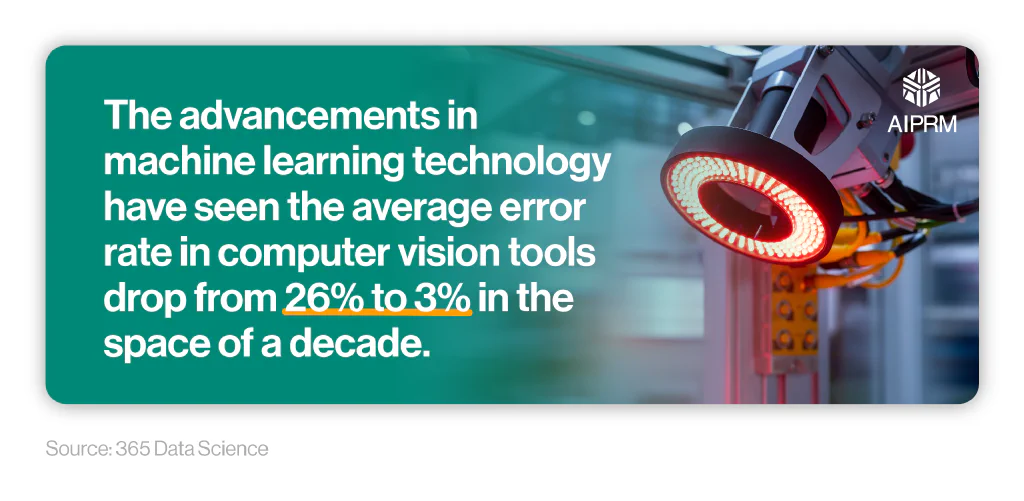
Chatbots #
The release of ChatGPT in November 2022 introduced the world to the newfound potential of chat-based AIs. This immediately revolutionized the capability of chatbots, with many companies using the software to create chatbots that were more intuitive and accurate in answering customer queries than ever before.
The impact of competent chatbots on a company’s marketing and customer service has already been proven, with KIA seeing their social media conversion rates rise by over a fifth (21%) with the launch of their Facebook messenger chatbot Kian in 2018.
With nearly three-quarters (74%) of consumers claiming they prefer chatbots when seeking answers to straightforward questions, further advancements in the field could boost the fortunes of both businesses and customers alike.
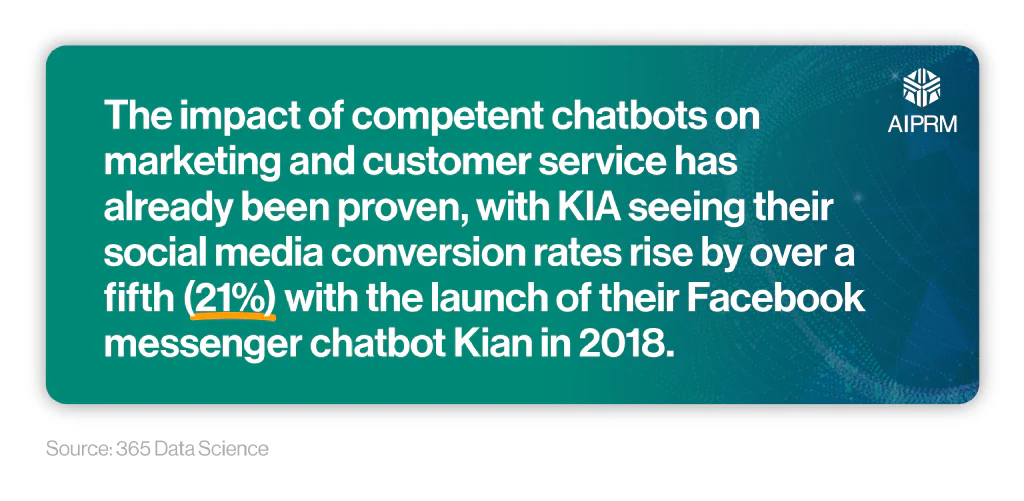
Online search #
Machine learning technology is the driving force behind a search engine’s ability to optimize its results. It does this by analyzing past data, previous searches, preferences, and trends.
With Google registering an average of 8.5 billion searches per day, it’s only natural that its algorithm continues to improve over time. The introduction of more advanced machine learning methods, combined with search engines’ increased intuitiveness from collating more customer data, should see the online search process become even more precise, accurate, and tailored than ever before.
Check out our blog for expert information on an array of AI topics including how eCommerce businesses can use ChatGPT for marketing.
Machine Learning FAQs #
What is machine learning?
Machine learning is an aspect of AI that provides machines with the ability to develop independent responses and actions by analyzing data, identifying patterns, and learning from past mistakes.
By doing these things extensively over large amounts of data, the machine is then able to develop more accurate and helpful responses to human commands and queries.
How does machine learning work?
Machine learning works by teaching a computerized device to recognize patterns within a set of data. The more the machine is exposed to the data, the more it can recognize these patterns and learn from previous mistakes, making it more accurate and intuitive when responding to human prompts.
What is the difference between AI and machine learning?
Artificial intelligence (AI) is the umbrella term for any computerized software that mimics human behavior to perform tasks and answer queries for us. Machine learning is an aspect of AI focused on training computerized devices to better deliver the tasks and answers requested by humans.
What is machine learning used for?
Machine learning has an array of uses, both in and out of the workplace. The technology has been used to train systems that automate tasks in numerous sectors including healthcare, manufacturing, retail, and security.
Additionally, machine learning is the technology used to train many programs we use in our everyday lives from chatbots to virtual assistant technologies like Siri and Amazon Alexa.
What is the difference between data science and machine learning?
Machine learning’s primary focus is to build algorithms that help computers learn from data patterns and make predictions. Data science seeks to extract independent insights and meaning from the data, using practices like statistical analysis and data visualization.
How many companies use machine learning?
A 2024 report from G2 found that more than half (57%) of businesses were using machine learning to improve customer experience. Additionally, a further 49% claimed they’d used the technology in their marketing and sales operations.
What is machine learning?
Machine learning is an aspect of AI that provides machines with the ability to develop independent responses and actions by analyzing data, identifying patterns, and learning from past mistakes.
By doing these things extensively over large amounts of data, the machine is then able to develop more accurate and helpful responses to human commands and queries.
How does machine learning work?
Machine learning works by teaching a computerized device to recognize patterns within a set of data. The more the machine is exposed to the data, the more it can recognize these patterns and learn from previous mistakes, making it more accurate and intuitive when responding to human prompts.
What is the difference between AI and machine learning?
Artificial intelligence (AI) is the umbrella term for any computerized software that mimics human behavior to perform tasks and answer queries for us. Machine learning is an aspect of AI focused on training computerized devices to better deliver the tasks and answers requested by humans.
What is machine learning used for?
Machine learning has an array of uses, both in and out of the workplace. The technology has been used to train systems that automate tasks in numerous sectors including healthcare, manufacturing, retail, and security.
Additionally, machine learning is the technology used to train many programs we use in our everyday lives from chatbots to virtual assistant technologies like Siri and Amazon Alexa.
What is the difference between data science and machine learning?
Machine learning’s primary focus is to build algorithms that help computers learn from data patterns and make predictions. Data science seeks to extract independent insights and meaning from the data, using practices like statistical analysis and data visualization.
How many companies use machine learning?
A 2024 report from G2 found that more than half (57%) of businesses were using machine learning to improve customer experience. Additionally, a further 49% claimed they’d used the technology in their marketing and sales operations.
Glossary #
Artificial intelligence (AI) #
AI is a form of technology that enables computers and machines to replicate human intelligence and problem-solving skills. AI is the umbrella term for a range of technologies including:
- Generative AI
- Virtual voice assistants
- Machine learning
ChatGPT #
ChatGPT is a chatbot and virtual assistant tool released by OpenAI in November 2022. The program has been trained using large language models (LLM) to respond accurately to human requests and questions.
Computer vision #
Computer vision refers to a type of AI in which computers are trained to correctly identify objects in images and videos.
Machine Learning #
Machine learning (ML) is a branch of artificial intelligence (AI) that uses data and algorithms to train machines to imitate human behavior to perform tasks.
Sources and methodology #
https://www.statista.com/outlook/tmo/artificial-intelligence/machine-learning/worldwide#market-size
https://www.statista.com/forecasts/1473233/ml-market-size-worldwide-by-region
https://learn.g2.com/machine-learning-statistics
https://www.statista.com/statistics/1358532/machine-learning-startups-funding-platforms/
https://www.pwc.com/gx/en/issues/analytics/assets/pwc-ai-analysis-sizing-the-prize-report.pdf
https://mobidev.biz/blog/future-machine-learning-trends-impact-business
https://www.techtarget.com/searchenterpriseai/tip/9-top-AI-and-machine-learning-trends
https://365datascience.com/trending/future-of-machine-learning/#5